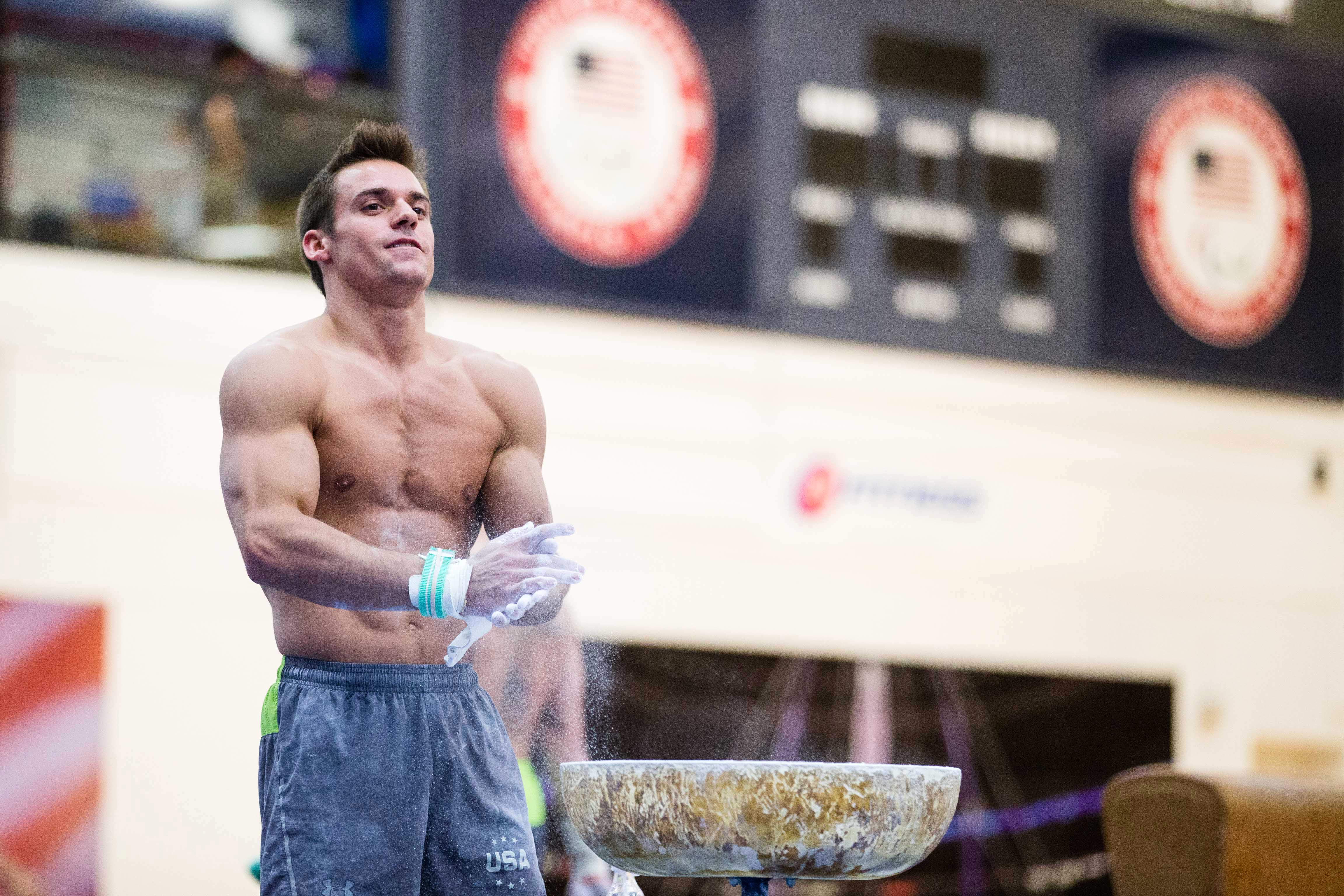COLORADO SPRINGS — Vitaly Marinitch grew up in a different gymnastics system, and he knows the American men he coaches won’t have the same experience he did in the Soviet Union.
But Marinitch, the U.S. resident program head coach, thinks they’re close. By choice, a bulk of the men’s national team has moved to live and train at the U.S. Olympic Training Center and created a de facto, pseudo-centralized system.
It’s not the same as Marinitch had when he moved away from home at 14 to train around 250 days a year. It was a sacrifice, but one that culminated in team gold for the Soviet Union at the 1989 world championships.
With the U.S. Olympic Trials this week, and the Games less than two months away, the veteran coach hopes his experienced team can reap similar benefits.
“That pushed us at that time to become the best in the world when I was on the world team in 1989,” he said this spring before a training session. “We’re trying to do something like this here as well, but it’s really not that easy to do in the United States because everybody has their own gyms they train at, with the NCAA programs or private clubs, so it’s really hard to get everybody in the same facility. I think we’ve done the best we could have, and having 10 guys here and eight of them on the senior national team, is tremendous, I think. It’s really been helping the U.S. team overall.”
Individually, several of the United States’ top gymnasts have made decisions that have formed the collective based in the mountains.
![Zika is among reasons many Americans skipping Rio Olympics [oembed : 86243174] [oembed : 86243174] [oembed : 86243174] [oembed : 86243174] [oembed : 86243174] [oembed : 86243174] [oembed : 86243174] [oembed : 86243174] [oembed : 86243174] [oembed : 86243174] [oembed : 86243174] [oembed : 86243174]](/Portals/_default/Skins/PrestoLegacy/CommonCss/images/smartembed.png)
Donnell Whittenburg came in 2013, with the Baltimore native seeking to work on the small things that would eventually take him from powerhouse gymnast with potential to become a world medalist.
For Sam Mikulak, the defending four-time U.S. champion, the change became necessary after he and his Michigan teammates graduated. Mikulak, a Southern California native, was still in Ann Arbor training, but with more distractions and without his friends there to push him, he needed an environment where he could focus on the Olympics rather than on NCAA goals.
“I just needed to get into a mindset where gymnastics was my life,” said Mikulak, “and that’s where I found Colorado Springs to be probably the best answer for me.”
Dennis McIntyre, vice president of the men’s program for USA Gymnastics, said the group has been filtering in this quadrennium after the London Olympics, with the last arriving about a year ago. Six gymnasts lived there before London, and now that number is up to 10.
Mikulak and John Orozco are 2012 Olympians living at the center. The group includes a mix of veterans like Chris Brooks and Paul Ruggeri with newcomers like Marvin Kimble.
“When you’re training next to guys that are going after the same goal that you are, it just really pushes everybody to that next level,”’ said national team coordinator Kevin Mazeika. “That’s irreplaceable. It just helps. It helps with the day-to-day training.”
For some gymnasts trying to make the five-man Rio team, staying close to home remains key. Olympians Danell Leyva and Jake Dalton are back trying to make a second team while training in Miami and Oklahoma, respectively.
“They’ve been training, some of them by themselves, in the gym without anybody pushing them around but they are self-driven,” says Marinitch, “so they’re still able to do so and get better.”
For Leyva, who is coached by his step-father, Yin Alvarez, staying close to home was important. And he gets high-level competition from a few international gymnasts who train at his gym.
For Dalton, staying in Oklahoma allowed him to stay with his collegiate coach, Mark Williams. As a perennial NCAA powerhouse, Oklahoma usually has several gymnasts in the mix for the national team.
And rather than hurt chemistry, they say the distance can help. Between Snapchat, Twitter and text messages, the guys remain in touch. Many of them have been competing with or against each other for years, and the team assembles for camp at the training center every six weeks.
“It’s kind of like a reunion,” says Dalton. “I don’t think it affects the chemistry at all. It’s almost a good thing. Sometimes you get a little bit of a break, you go home and then you’re looking forward to going back and hanging out with those guys.”
![Armour: IOC gives in, allows some Russian track athletes to compete in Rio [oembed : 86243196] [oembed : 86243196] [oembed : 86243196] [oembed : 86243196] [oembed : 86243196] [oembed : 86243196] [oembed : 86243196] [oembed : 86243196] [oembed : 86243196] [oembed : 86243196] [oembed : 86243196] [oembed : 86243196]](/Portals/_default/Skins/PrestoLegacy/CommonCss/images/smartembed.png)
The benefit has not only been depth, but quality of depth, Mazeika said. The guys who are there push each other on a daily basis, and that continues when the whole team gathers for camps.
It has paid off in results, with the U.S. men winning nine world championship medals in this quadrennium leading up to Rio. That’s more than in any quad since the late 1970s.
While that makes for difficult decisions coming out of the trials process, Marinitch hopes the depth built of the pseudo-centralized system can pay off the way his experiences did.
“The more good guys we have, the more competition is going to be, the better the team is going to be. In countries like China and Russia when they were dominating, that’s what they had,” he said. “I think United States men’s program comes to that point now where we have such depth where that creates competition within and I think we’re gonna produce one of the best Olympic teams because of that. I hope so. Whoever the five guys make the team, they’re in very good position to compete for the medals and possibly gold medals.”
![sports-itunes-olympics [embed : 71637744]](/Portals/_default/Skins/PrestoLegacy/CommonCss/images/embed.jpg)
![Weighing in on IOC's latest stance on Russia by Going for Gold [oembed : 86262814] [oembed : 86262814] [oembed : 86262814] [oembed : 86262814] [oembed : 86262814] [oembed : 86262814] [oembed : 86262814] [oembed : 86262814] [oembed : 86262814] [oembed : 86262814]](/Portals/_default/Skins/PrestoLegacy/CommonCss/images/smartembed.png)
![U.S. men's gymnastics benefits from team-focused training [video : 86274364]](http://videos.usatoday.net/Brightcove2/29906170001/2016/06/29906170001_4975949650001_4975824542001-vs.jpg?pubId=29906170001)


![2016-6-21-sam-mikulak [image : 86242600]](http://www.gannett-cdn.com/media/2016/06/22/USATODAY/USATODAY/636021938993847803-USP-GYMNASTICS-USA-GYMNASTICS-MEN-S-TEAM-TRAINING-81522861.JPG)
![2016-6-21-naddour-mikulak [image : 86242914]](http://www.gannett-cdn.com/media/2016/06/22/USATODAY/USATODAY/636021941827293966-USP-GYMNASTICS-USA-GYMNASTICS-MEN-S-TEAM-TRAINING-81522867.JPG)
